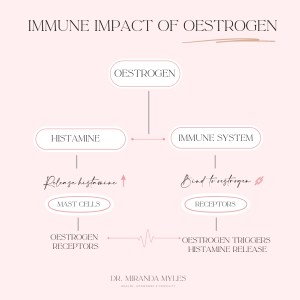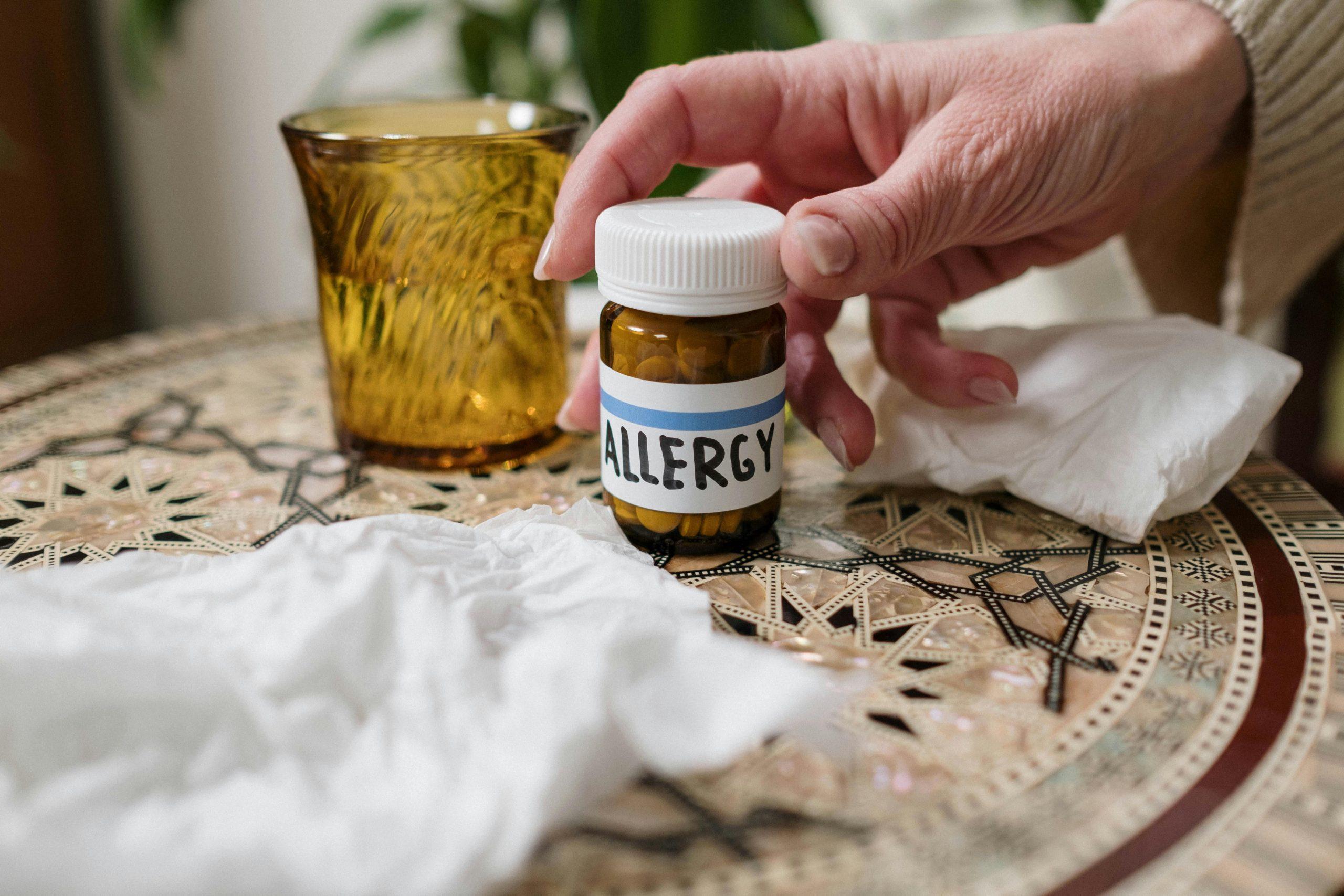Ever wondered why your body reacts mysteriously to certain foods or experiences unexplained symptoms? In this article, we delve into the captivating world of histamine intolerance, shedding light on its multifaceted manifestations and the profound impact of Oestrogen on its dynamics.
Histamine: The Double-Edged Sword:
Histamine, often associated with allergy symptoms like sneezing and itching, serves as a crucial messenger in our body’s immune response. However, excessive histamine levels can lead to histamine intolerance, a condition characterized by a wide array of systemic effects spanning multiple organ systems.
Oestrogen’s Role in the Histamine Drama:
Enter Oestrogen, a powerful hormone with a significant influence on histamine production and release. Oestrogen binds to receptors on mast cells, triggering the release of histamine, particularly in the uterus and ovaries. This Oestrogen-histamine axis forms a delicate balance, with fluctuations in Oestrogen levels affecting histamine dynamics throughout the menstrual cycle.

What is Histamine Intolerance?
Histamine intolerance presents a complex clinical picture, encompassing gastrointestinal, respiratory, cardiovascular, integumentary, and central nervous system symptoms. Factors contributing to histamine intolerance range from impaired enzyme activity and excess histamine synthesis to dietary triggers, medication interactions, and stress-induced mast cell activation.
Oestrogen, Progesterone, and the Mast Cell Connection:
Mast cells play a pivotal role in the complex interaction among estrogen, progesterone, and histamine.With receptors for both Oestrogen and progesterone, mast cells are influenced by the hormonal fluctuations of the menstrual cycle, potentially contributing to menstrual-related symptoms such as headaches and dysmenorrhea.Additionally, histamine’s inflammatory effects can contribute to heightened sensitivity and reactivity during menstruation, exacerbating symptoms of pain and discomfort.
Certain foods rich in histamine or capable of inducing histamine release from mast cells may exacerbate symptoms of histamine intolerance, especially during specific phases of the menstrual cycle. Citrus fruits, tomatoes, pineapple, bananas, and strawberries are examples of foods that may trigger histamine release. Additionally, fermented foods (e.g., sauerkraut, kimchi, kombucha), processed meats, and aged cheeses (e.g., Parmesan, cheddar, blue cheese)contain high levels of histamine and are best consumed in moderation, particularly during times of hormonal fluctuation.
Recognizing Symptoms of Oestrogen-Related Histamine Intolerance:
When Oestrogen and histamine become entangled, symptoms can manifest uniquely for each individual. Here’s a glimpse into common signs that may hint at a connection between histamine intolerance and Oestrogen imbalance:
- Headaches:Persistent headaches or migraines, especially during hormonal fluctuations, could signal Oestrogen-related histamine intolerance.
- Fatigue: Unexplained fatigue or low energy levels, often accompanied by lethargy, may point to disrupted histamine metabolism influenced by Oestrogen.
- Skin Rash: Redness, itching, or inflammation may occur due to heightened histamine levels influenced by Oestrogen fluctuations.
- Hives: Itchy welts on the skin, known as hives or urticaria, could result from increased histamine release triggered by Oestrogen dominance.
- Brain Fog: Difficulty concentrating, mental fogginess, or memory lapses might indicate an imbalance in histamine and Oestrogen, impacting cognitive function.
- Food Intolerances: Heightened sensitivity or adverse reactions to certain foods, particularly histamine-rich or histamine-releasing ones, may indicate underlying histamine intolerance exacerbated by Oestrogen influence.
- Menstrual Cramps:** Intensified pelvic discomfort, particularly during ovulation or menstruation, may be exacerbated by elevated histamine levels associated with Oestrogen dominance.
- Gut Imbalance: Digestive disturbances such as bloating, abdominal pain, and diarrhea may arise from disrupted histamine metabolism in the gastrointestinal tract, worsened by fluctuations in Oestrogen levels.
Recognizing these symptoms collectively suggests an underlying imbalance between Oestrogen and histamine, underscoring the need for further exploration and potential intervention to restore hormonal equilibrium and alleviate discomfort. If you resonate with any of these signs, it’s advisable to consult a healthcare professional for personalized assessment and management strategies tailored to your unique needs.
At Freyja Health Clinic, we invite you to embark on a meaningful conversation about your fertility goals. Our team is dedicated to providing comprehensive care and personalized solutions tailored to your individual needs. We are committed to equipping you with the tools to optimize your health and achieve your fertility aspirations. Your well-being is our priority, and we eagerly await the opportunity to assist you on your journey to a healthier and more fulfilling life.
Research References:
Dr Miranda Myles Natural Health & Fertility, Naturopath & Acupuncturist, is passionate about working with couples in the management of their fertility issues. Miranda is dedicated to help couples achieve optimal physical and emotional health prior to conception. Miranda provides a beautifully supportive and nurturing environment to allow you to reach your optimal health goals, to enable you to achieve a successful conception, pregnancy and baby.

Share This Story, Choose Your Platform!
Related Posts

Endometriosis is a chronic inflammatory condition where tissue similar to the uterine lining grows outside [...]

Christmas is a time of joy, celebration, and indulgence—but it can also be a whirlwind [...]

Postnatal depletion is a condition many new mothers experience but is often overlooked. Unlike postpartum [...]

![Endo is tricky.
It’s not just “bad period pain.” The most common signs? Period pain (aka dysmenorrhea) and fertility challenges. But here's the catch - not everyone with endo experiences these. Some women don’t even know they have it because their symptoms seem totally unrelated to their cycle.
The problem? Endo is still wildly misunderstood, even by doctors. As the New York Times put it:
'Endometriosis] suffers from a branding problem: It falls into the abyss of ‘women’s diseases’ (overlooked), diseases that don’t kill you (unimportant), and menstrual problems (taboo).’
If you’ve been dismissed or told your pain is “normal,” you're not crazy. Your symptoms deserve to be taken seriously.
💡 Save this for your next doctor's visit.
Tag someone who needs to see this ⬇️
#drmirandamyles #ttccommunity #explorepage✨
#endowarrior #endo #endometriosis #endoawareness #endoawarenessmonth #endopain #endodiagnosis](https://www.mirandamyles.com.au/wp-content/plugins/instagram-feed/img/placeholder.png)
